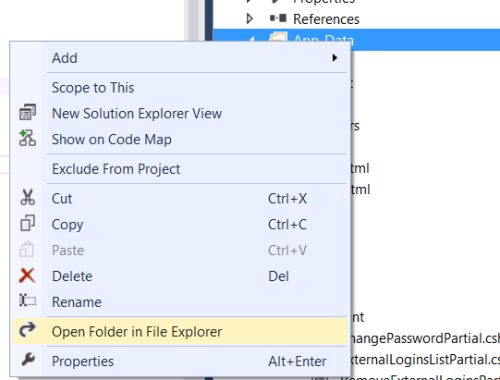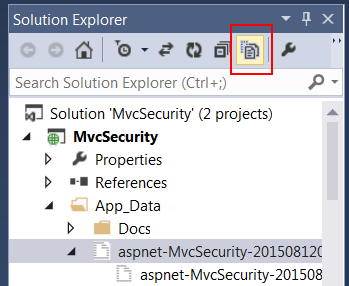Archive for August, 2015
MVC – Fixing those broken images
Posted by scottstoecker in MVC on August 27, 2015
MVC is full of all sorts of wonderful pitfalls features.
While working on a site, if I loaded up the default site I was debugging (http://localhost:3316) with no controller or actions segments , and the images on the page appeared. When I went all fancy and used http://localhost:3316/Home, then the images broke, and there was much gnashing of teeth. And a little crying, but that was probably the hot sauce.
However, I found an excellent post on Peter Seale’s blog about using prepending a “~/” onto a link. And I found that life got better when I did that. So if I have this image URL:
Images/cat.png
That may not work because of the twists and turns that is MVC. If your images do break when navigating to a particular view from a different way, try the “~/” trick:
~/Images/cat.png
You may just leave happy. Maybe.
404 error calling an MVC controller action
Posted by scottstoecker in Ajax, Error, MVC on August 26, 2015
There are two reasons I have seen this so far, and I have included both. I have creatively labeled them “Reason #1” and “Reason #2”. I leave it to you what will happen if I find a third reason.
Reason #1
I was using Ajax to call an MVC action like so:
$.ajax({
type: 'GET',
url: '@Url.Content("~/Home/Stuff")',
success: function (data) {
$('#results').replaceWith(data);
}, error: function (xhr) {
alert(xhr.statusText);
}
});
And my Stuff action in the Home controller:
private ActionResult Stuff() {
return PartialView("~/Views/Home/Stuff.cshtml");
}
But, I was deeply saddened to see that I was getting a “404 Not Found” error when I tried to do this. And it was because I made a simple mistake and hadn’t made my Stuff action public. Making that change fixed the issue:
public ActionResult Stuff() {
return PartialView("~/Views/Home/Stuff.cshtml");
}
Reason #2
The second reason was that the URL was pointing to the wrong location. Shocker, I know. But here is the code that was causing the 404:
$.ajax({
url: '/Account/GetUsers',
method: "GET",
});
It appears that this would be fine – calling my controller Account, and the action GetUsers. However, this is ignoring that jQuery doesn’t know the complete path. The right code is:
$.ajax({
url: '@Url.Content("~/Account/GetUsers")',
method: "GET",
});
MVC – Retrieving data using jQuery and Ajax
Posted by scottstoecker in Ajax, jQuery, MVC on August 21, 2015
Retrieving text using MVC through jQuery and Ajax is fairly simple. What I wanted to happen was to have a link that loaded a DIV when the user clicked it. So the really simple HTML:
<a href="#" onclick="load()">Support</a>
The jQuery for this request wasn’t much, either. Just a simple GET request pointing to the controller and action:
function load() {
$.ajax({
type: 'GET',
url: '@Url.Content("~/Home/Test")',
success: function (data) {
$('#results').text(data);
}, error: function (xhr) {
alert(xhr.statusText);
}
});
}
And the Home controller, Test action:
public string Test() {
return "Testing";
}
I did run into a problem where I was getting “404 Not Found” errors when I attempted to access the action. This was happening because my action was declared as private, so the 404 message made perfect sense.
ASP.NET membership database not appearing in the App_Data folder
Posted by scottstoecker in .NET, MVC, SQL on August 14, 2015
Reading over some MVC documentation at https://msdn.microsoft.com/en-us/library/ff398049(v=vs.100).aspx, I noticed several people complaining that they couldn’t see the database after building the application. I went to my App_Data folder and I saw the same behavior – no database. Even restarting Visual Studio didn’t reveal the database.
However, you should be able to view the database by right clicking on the App_Data folder and selecting “Open Folder in File Explorer”.
You can also click on the “Show All Files” icon, and should reveal it as well:
Getting Latitude / Longitude from a SQL Server Geometry
Posted by scottstoecker in SQL on August 13, 2015
Do you need to pull the latitude and longitude values in format you know and love into a VARCHAR, like “41.848, -82.690”? No problem:
SELECT CONVERT(VARCHAR(20),[Geometry].STY) + ‘,’ + CONVERT(VARCHAR(20),[Geometry].STX) FROM MyPlaces
Selecting empty SQL geometry values
Posted by scottstoecker in SQL on August 11, 2015
Selecting empty geometries is easy. All you need is SQL Server, some data with a column of the Geometry data type, and this query:
SELECT * FROM ScottsFavoriteBars WHERE [Geometry].STIsEmpty() > 0
‘Invalid column name’ error in SQL update statement
Posted by scottstoecker in Error, SQL on August 7, 2015
I was getting this error in my SQL statement, which was dynamically created in some C# code:
Invalid column name “385f35a5-697a-4238-b502-c5a72199d9c2”
An example of the statement:
INSERT INTO Test (ID)
VALUES ("385f35a5-697a-4238-b502-c5a72199d9c2")
This error was because my SQL INSERT statement had used double quotes around the text to be inserted instead of single quotes. Modifying the statement fixed it:
INSERT INTO Test (ID)
VALUES ('385f35a5-697a-4238-b502-c5a72199d9c2')
ASP.NET MVC – Attribute to analyze calling controller and action
Posted by scottstoecker in ASP.NET, C#, MVC, Security on August 3, 2015
I needed to create an ASP.NET MVC attribute to attach to my controllers and have them affect all actions. The attribute would apply like so:
[ScottAuthorize]
public class AdvisoriesController : BaseController {
// Really important business logic
}
What the attribute needed to do was analyze the controller and action being referenced, look up in a database whether the user actually had access to those actions (a custom role management system), and then grant or deny access based on the results. Here is a bit of that attribute to show how I did that:
public class ScottAuthorizeAttribute : System.Web.Mvc.AuthorizeAttribute {
protected override bool AuthorizeCore(HttpContextBase httpContext) {
string controller = httpContext.Request.RequestContext.RouteData.Values["controller"].ToString();
string action = httpContext.Request.RequestContext.RouteData.Values["action"].ToString();
// Really important authorization stuff
return true; // Or false, of course. } }
If you are so awed by this code that you want to pay me, I’ll give you an address and you can send cash. I only accept pennies from 1970 – 1980 in good condition.


Recent Comments